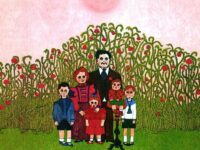When I lived in a college dormitory, a guy down the hall from me turned me on to this ECM record Silent Feet by Eberhard Weber. The two long tracks and the one even longer track were entrancing to me, like going on this audial odyssey. Even though the record had already been out for about ten years, it sounded just as fresh as yesterday. I made a cassette copy of it and played the crap out of it for the next couple of years.
That got me into Weber’s music and eventually I acquired actual Weber records, but that particular album’s shine from the time I first laid ears on it has never faded. It was in the middle of a certain phase in Weber’s long and productive career, during the time he led a multinational fusion band called Colours. Last January, ECM commemorated the Colours recordings by packaging all three Weber records released under “Eberhard Weber Colours” into a box set. The name of this box set is, you guessed it, Colours.
There are several reasons why Colours was such an appealing group, and it started with the leader himself. The German Eberhard Weber was and remains the most poetic, melodic bassist I’ve ever heard, with the exception of Jaco Pastorious. He also is the owner of a gorgeous tone and has a great sense of harmonics. Some of his distinct sound is attributable to his unique instrument, a sort of electrified version of a stand-up bass with an extra, fifth string he calls an “eletrobass.” These are no doubt qualities that compelled Pat Metheny to ask Weber play on his second album Watercolors, after having Pastorious play on his first. Weber is also a composer and arranger of the highest order, as well, for ensembles both large and small.
Weber created Colours to be a small ensemble, a quartet. It lasted from 1975 until 1981 with only one lineup change. Charlie Mariano, who was about a year removed from his stint with the short-lived but powerful fusion supergroup Pork Pie, was the main soloist in Colours, and his soprano saxophone was very expressive and retaining much of his bebop roots as well as Eastern/Indian influences. Weber’s fellow German Ranier Brüninghaus is not a name that comes up often in discussions about jazz keyboardists, but he’s done a fine job every time I’ve heard him in a sideman role. For Colours, he demonstrated a mastery of the electric piano, and how to use its pliable tonal palette to create the textures Weber wanted for his recordings. He also played piano with a classically-trained approach and played synthesizers in a tasteful, understated way that has stood the test of time better than most synthesizer treatments of the day. For the first couple of years, Jon Christensen was the drummer for Colours. One of long time stalwarts for ECM, this Norwegian percussion specialist is a master at constructing the right rhythmic shapes for what the music calls for. His cymbal work is outstanding and he employs an energetic yet light touch on his drum set. The Englishman John Marshall replaced Christensen in 1977 and is probably best known as the drummer who replaced Robert Wyatt at The Soft Machine. He also played on a couple of Nucleus’ earliest records, and participated on a large number of jazz and jazz-rock dates over a span of several decades. Like Christensen, he’s a master at applying enhancing accents, but brings a somewhat more muscular drive. And he stays very close in tune with what the others are playing, as playing “on his feet” was required to fit in at The Soft Machine.
The name of this band is derived from Weber’s first album, The Colours Of Chloë (1973), Weber’s highly acclaimed masterwork which did much to set the template for what became known as “the ECM sound.” On that album, Weber found the formula for combining classical, jazz, minimalism and new age currents into a modern, mellifluous whole. Brüninghaus participated very meaningfully in those groundbreaking sessions. The band Colours was by and large Weber’s way of following up on the ideas he presented there. He wanted to translate those ideas to a smaller scale, a quartet that can take his songs on the road. Weber assembled this crew and went into the studio in September, 1975. Having established a legacy, Weber started building upon it:
Yellow Fields (1975)
Weber’s first Colours album, like Keith Jarrett’s Koln concert from about the same time, introduced the band as one that went against the prevailing conventions about fusion at that time. Instead of blazing technique, Weber was far more interested in colors, harmonics, textures and ensemble playing. The music was performed with only occasional changes and kept solos fairly short, even as the songs themselves are often extended out to the fifteen minute range. In those ways, Colours was a lot closer to the kind of fusion pioneered by Miles Davis than some of the groups spun off from his band. Yellow Fields established this style and the group more or less stuck with it over the following two Colours releases.
“Touch” is an airy group improvisation piece that suggests what Weather Report might have sounded like in the mid-seventies had they stuck with the principles they established at the beginning when Miroslav Vitous was in the band. At five minutes long, this hardly qualifies for song-length by Colours standards (there are only 12 tracks in the entire, 3-disc box set). “Sand-Glass” is the centerpiece track of Yellow, a slowly unfolding, gorgeous harmonic textures anchored by Weber’s high register ostinato. Mariano is golden on this track; he follows up his subdued, elongated notes perfectly rendered on soprano with a more urgent ruminations on the acidic Indian reed instrument, the nagaswaram. Later on, Christensen and Brüninghaus combine for an inspired, idiosyncratic synth-drum exchange. “Yellow Fields,” the song moves from a sparse, suspended intro into a marching defined theme, the only such one on the album, and revisits it after a modal solo section, in one of the most direct jazz expressions of the whole box set. Brüninghaus’ Fender Rhodes solo is the standout moment. The first part of “Left Lane” glows with soft colors and shapes built jointly by Christensen, Weber and Brüninghaus on Rhodes. The middle section features Brüninghaus performing a classical piano patterned solo and following that, the pace quickens to an odd time signature on which both Mariano and Brüninghaus back on Rhodes create sonic sketches to Weber’s repeating figure canvas.
Silent Feet (1977)
My sentimental favorite, Silent Feet is also the least structured one: more than the other two, the quartet begins with broad ideas as jumping off points to create on the fly and go with the flow. Put another way, they’re jamming on this one. Being Colours, this isn’t the hard kind of jamming, the combo stays light on its feet and leaves vast amounts of space, making deeply impressionistic sounds.
“Seriously Deep” was an eighteen minute, side-long track on the vinyl version, and makes masterful use of classically-inspired motifs and cadences mostly off a single chord, without it really being classical at all. Weber spins a resplendently mournful solo that is full of character and soul, and so uniquely himself that he practically writes his signature with it. “Silent Feet” starts as a song searching for a melody until it finds one after a couple of minutes. Brüninghaus and Marshall lock into a furious groove that paves the way for the prancing, joyful chorus. A slower, more somber interlude follows as this song traverses over moody terrain, but the journey is rewarding those who commit to the ride. “Eyes That Can See In The Dark” begins with Mariano’s tribal wood flute and transitions into a lovely waltz highlighted by Brüninghaus’ nimble piano and Mariano, this time returning to soprano saxophone.
Little Movements (1980)
Weber’s background and interest in classical music come closer to the fore on this album; “The Last State Of A Long Journey” is chamber jazz with an emphasis on “chamber” and there’s not even any rhythms played on the album until about three minutes into the next track, “Bali.” “Journey,” with a beautiful folk melody, would later be revisited by Weber on two more of his albums. “Bali” is the only non-Weber composition of these three albums; Brüninghaus’ piece fits right in the Colours blueprint for blending the structure of chamber music with the unstructured creativity of advanced jazz all rolled up in a modern, fusion/new age wrapper.
“A Dark Spell” and “Little Movements” both revolve around a repeating pattern, this time played by Brüninghaus’ piano. In the former song, though, Marshall’s role subtly moves from providing shadings to driving the song through ever-shifting rhythms, while in the latter song, Brüninghaus’s ostinato is keeping time, freeing up Marshall as Weber and Mariano devise layers of counter-melodies. The closer “‘No Trees?’ He Said” is one of Colours’ catchier tunes, which makes it easier to overlook the intricacies going on underneath, and the airiness of it recalls early Pat Metheny Group (it could be argued that early PMG in turn owed a lot of its sound to Weber’s first couple of albums).
After their 1981 disbandment, Weber never reconvened Colours, preferring to pursue other musical interests. Mariano’s death last year makes the chances for a reunion even more remote. These twelve tracks were enough to make the point, however. Weber successfully downscaled his grand scheme devised for The Colours Of Chloë into a nimble little group and influenced many of his ECM label-mates as well as other major contemporary jazz musicians on both sides of the Atlantic. For someone wanting to discover how good ECM’s plugged-in music can be or looking for an introduction to the artistry of one of Europe’s finest bassists, the Weber box set is well worth the investment. And trust me, it sounds so much better than a cassette copy.






thank-you for the fine description of colour's music!
eberhard weber and steve tibbett's ecm music escorted me into an appreciation for the spaces between the notes, a la this lovely fripp quote, "Music is the cup that holds the wine of silence." _silent feet_ was my initiation (around 1979), and it remains among the most consistently satisfying recordings i've encountered, to this day. *that's* remarkable. (tibbett's _northern song_ and _safe journey_ are in that set, too.)
ken manheimer
http://myriadicity.net
Thanks for the comment, Ken. Glad to see others who appreciate these Weber records as immensely as I do.
Enjoyed the review. Does anybody know how Weber is doing since his stroke a few years back?
Pingback: Gary Burton/ Chick Corea - Crystal Silence, The ECM Recordings 1972-79 (2009) | Something Else!
Pingback: Lyle Mays, "Eberhard" (2021): One Track Mind